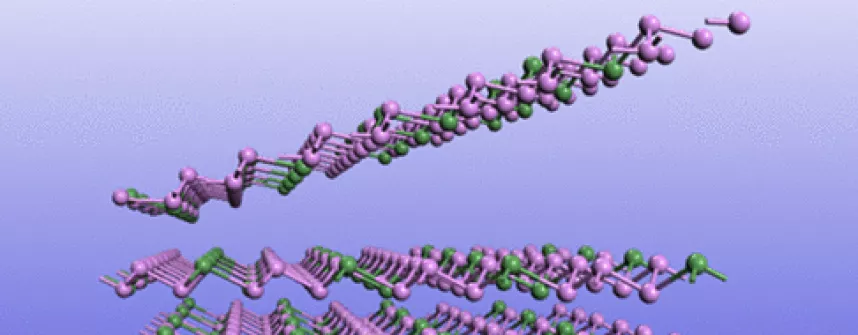Two-dimensional wonder material could make computers even faster
Structure of GeP3
February 13, 2017
From generation to generation, high technology products are getting faster and more powerful. Again and again, new materials with new properties are needed to allow for continuous technological progress. On the search for promising future materials, scientists of Wilhelm-Ostwald-Institute of Physical and Theoretical Chemistry at Leipzig University and Jacobs University Bremen were the first ones to investigate the properties of a promising new socalled two-dimensional material, germanium phosphide. Thanks to their research, it could become possible to make computer processors even smaller and faster to make solar cells more efficient. Their research results have been published in the renowned journal “Nano letters”.
“After the discovery of the two-dimensional (2D) material graphene, phosphorene was considered to be the new wonder material of nano electronics, as it has fantastic electronic properties. It has, however, a serious problem: it is not stable in air, which makes it difficult to handle in the laboratory,” says Thomas Heine, professor of theoretical chemistry at Leipzig university and Adjunct professor at Jacobs University.
Heine and his team had the idea to stabilize the reactive phosphorus by addition of the element germanium. “Germanium phosphide has been made and reported already in the 1970’s, but the material has been dismissed from further research due to its rather unspectacular properties,” explains the chemistry professor. They are now the first to recognize the material’s enormous potential for applications, in particular in its two-dimensional variant. “Besides its excellent electronic properties it is chemically stable.” Therefore, it is much easier to handle and to fabricate than phosphorene.
2D materials are crystalline substances with a thickness of only one or few atomic layers. “Thinner is impossible”, as Prof. Heine puts it in a nutshell. Stacked on top of one another they form so-called layered materials, which have properties that are typically distinct of their two-dimensional counterparts. 13 years ago, the first 2D material, graphene, has been manufactured by Novoselov and Geim, who have been rewarded with the Nobel prize. This initiated the search for further 2D materials with extraordinary properties.
Germanium phosphide could be particularly promising. Based on calculations, the team has now predicted that the material changes its properties with the number of atomic layers: if it is formed by three layers, it has the properties of a metal, As a single- or double layered structure the material becomes a semiconductor.
"This sudden change of properties was very surprising to us, and it opens entirely new possibilities. Electronic switches, such as transistors, are made of semiconductors, their contacts are, however, metallic. With germanium phosphide it becomes possible to fabricate both components out of one
material,” explains Dr. Yu Jing, first author of the related publication in the journal “Nano Letters”. “Moreover, in germanium phosphide the charge carriers are very mobile. This makes them particularly interesting for fast electronic applications as computer processors and memory.” And besides that, the
material has properties that are important for the production of low-cost solar cells with high efficiency. The required raw materials, germanium and phosphorus, are cheap and available nearly everywhere on the planet.
Additional information:
Publication in "Nano Letters": "GeP3: A small indirect band gap 2D crystal with high carrier mobility and strong interlayer quantum confinement", DOI: 10.1021/acs.nanolett.6b05143
http://pubs.acs.org/doi/abs/10.1021/acs.nanolett.6b05143
www.jacobs-university.de
Contact:
Thomas Joppig | Brand Management, Marketing & Communications
t.joppig [at] jacobs-university.de | Tel.: +49 421 200-4504
